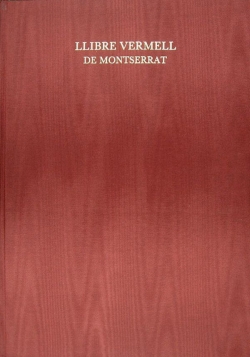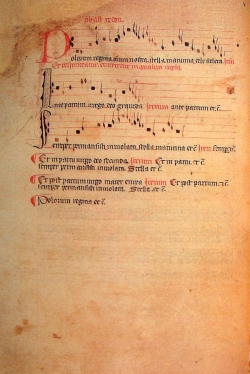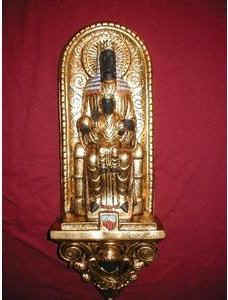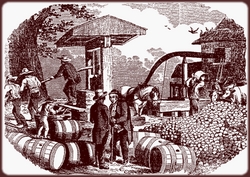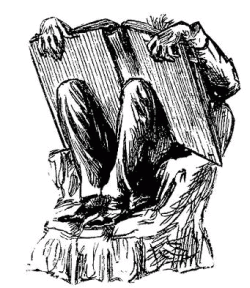Llibre Vermell
and the
Legends of Montserrat
Outside of Barcelona, Spain, is the legendary monastery of Montserrat, the site of religious pilgrimages for a long time, possibly going back even before the Christian era.
The monastery can be found about halfway up the steep, barren mountain. Only ruins can be found of the 11th-century Benedictine monastery, the new monastery on the site was built in the 19th century.The monastery at Monsterrat is home to one of the famous "Black Virgin" statues. More about such statues and the history and legends of the Black Virgins later......
The monastery of Montserrat has long been a center of devotion for the Virgin Mary. Legends say that the Virgin Mary has performed numerous miracles there which explains the fact that the mountain had been inhabited by hermits as early as the end of the ninth century. During this time the mountain was reconquered from the "Saracens" and given to the Benedictine monastery of Ripoll by the counts Wifredo and Suner.
The monastery of Santa Maria de Montserrat was created out of one of the hermitages. A large number of pilgrims went there, mainly because of their belief in the wonder-working powers of the black statue of the Virgin Mary . The monastery was also a cultural center of the first order. Some of the monks residing their had studied at far away universities like Paris or Bologna. Clerics from noble Spanish families, mostly from Catalonia, represented the aristocracy in Montserrat through their celebration of daily masses.
This is how Montserrat became the spiritual, cultural and political center of Catalonia.
With the conquests of the Catalon-Aragonese crown, Montserrat became famous worldwide: Churches were built in honor of the Virgin from Montserrat in Mexico, Chile and Peru. In the colonies, islands and settlements were named after her. After the almost complete devastation of the monastery by Napoleon in 1811, Montserrat regained its former significance only during the Catalonian 'Renaixença' and its rebuilding at the end of the nineteenth century.
Libre Vermell
the Red Book of Montserrat
One of the most precious treasures from the library of Montserrat is a codex from the late fourteenth century, the 'Llibre Vermell' or 'Red Book'.
The manuscript is named after it's red velvet cover which was created in the late 19th century. 35 of the original 172 sheets in folio of this manuscript are lost today. Besides various other contents, mainly for liturgical use, one of the fascicles (folio 21v - 27r) contains ten musical works (notated during the years 1396-1399).
An anonymous scribe explains in the text of the book, the intended function of the pieces which were copied by him:
"Quia interdum peregrini quando vigilant in ecclesia Beate Marie de Monte Serrato volunt cantare et trepudiare, et etiam in platea de die, et ibi non debeant nisi honestas ac devotas cantilenas cantare, idcirco superius et inferius alique sunt scripte. Et de hoc uti debent honeste et parce, ne perturbent perseverantes in orationibus et devotis contemplationibus."
Translation:
"As it happens that the pilgrims, while holding night vigil in the church of the Blessed Virgin from Montserrat, sometimes desire to sing and to dance and even so during the day, in the Church Square, where only virtuous and pious songs may be sung, some suitable songs have been written down here for this need. These should be used in a respectful and moderate manner, so as not to disturb those who wish to continue their prayers and religious contemplations."
Since there was no pilgrims hostel at Montserrat, the visitors spent the night in the church, thus rearranging the liturgical room into a hostel. The songs of the Llibre Vermell were meant to replace the traditional secular songs and dances performed by the celebrating pilgrims during the night vigil. Fitting to this task, the "Cants dels Romeus", the songs of the pilgrims, have a popular tone. Some Spanish traditional melodies were probably also used, but their original lyrics were substituted by religious texts which should communicate essential points of the christian doctrine of salvation to the faithful. The erudite and and well-travelled monks from Montserrat also combined musical influences from different European regions.
MP3 arrangements from Llibre Vermell
Arranged for solo guitar, with choral background accompaniment
Laudemus Virgenum - MP3 sample
Cuncti Sumus
Polorum Regina
Imperaytritz Dela Ciutat
Mariam Matrem
Splendens Ceptigera
Los Set Goys
O Virgo Splendens
Laudemus Virgenum
Stella Splendens
Ad Mortem Festinamus
Downloading The
MP3 collection......You can download the complete collection of MP3s in the form of a "zip" file for $6.00 by using the link below.
After your secure Paypal or Credit Card payment is processed, you will be immediately be sent an email with the download link.Purchase the Llibre Vermell MP3 collection
If you have any questions about this collection,
contact us at e-mail
Legends Of Montserrat
There are many legends concerning the mountains and monastery of Montserrat.
One legend tells that in the year 880, on a Saturday night when the sun was going down over Montserrat, some boy shepherds saw a bright light coming down from the sky, accompanied by beautiful music. The following Saturday they returned with their parents. And the vision came to them again. On the following four Saturdays the Rector of Olesa went with them. And everyone saw the vision.
As soon as he heard about what had happened, the Bishop of Manresa arranged a visit. A grotto was seen where the image of the Holy Mother of God was found. The Bishop suggested that the image be taken to Manresa, but as soon as it was lifted up, it became so heavy that it could not be moved. The Bishop
interpreted this as the manifestation of the will of the Virgin to stay in that place. He ordered a chapel to Mary to be built and that she be worshipped on the mountain of Montserrat.
The Black Virgin
& Mary Magdalene
If it is true that a large proportion of the ancient miraculous Madonnas of the world are black, why is this phenomenon generally so little known today? A poetic verse from 1629 catalogues some of the national shrines of Europe, all of which, at the heart, seem to represent an ancient tradition of devotion to a statue of the Black Virgin. Many such Black Virgins exist, often having survived centuries of war, some in large basilicas, others in village churches, yet others in museums and libraries. Many more are also in private hands, for a variety of
reasons. Some are painted statues, others are murals or paintings, and some are statues carved from ebony.
Some of the most famous Black Virgin shrines are Chartes, Loreto, Zaragoza, Rocamadour, Montserrat, and Guadalupe. Early textual references describing images of Black Virgins are few, although Peter Comestor (12th c. biblical scholar of Troyes and Paris), St. Bernard of Clairvaux (an early leader of the medieval Knights Templar) and Nicephorus Callixtus (1256-1335), the Byzantine church historian, all have had something to say on this subject.
There is also a strong religious folk tradition connecting the Black Virgins to the medieval Knights Templar and also with Mary Magdelene. A famous Black Virgin - la Madone des Fenestres (the Madonna of the Windows), near St-Martin-de-Vesubie (one site where many Templars were massacred) was believed by folk tradition in the area to have originally been brought to southern France by Mary Magdelene. Whether such legends spring from a kernel of truth, or are purely legendary, it is still intriguing to examine the sheer number of such place-names, legends, and beliefs about these subjects and their interconnections, at least in the popular mind. And that in itself says something.
Montserrat & The Holy Grail
According to the Columbia Viking Desk Encyclopedia (1968 version), Montserrat was thought in the Middle Ages to have been the site of the castle which contained the Holy Grail. Says the encyclopedia, "The Renaissance church contains a black wooden image of the Virgin, carved, according to tradition, by St. Luke. In the Middle Ages the mountain, also called Monsalvat, was thought to have been the site of the castle of the Holy Grail."
In Christian mythology, the Holy Grail was the dish, plate, cup or vessel that caught Jesus' blood during his crucifixion. It was said to have the power to heal all wounds. A theme joined to the Christianized Arthurian mythos relates to the quest for the Holy Grail.
A number of knights undertook the quest for the Grail, in tales that have become annexed to the Arthurian mythos. Some of these tales tell of knights who succeeded, like Percival or the virginal Galahad; others tell of knights who failed to achieve the grail because of their tragic flaws, like Lancelot. In Wolfram's telling, the Grail was kept safe at the castle of Munsalvaesche (mons salvationis) or Montsalvat, entrusted to Titurel, the first Grail-King. Some, not
least the monks of Montserrat, have identified the castle with the real sanctuary of Montserrat in Catalonia.
Early American music,
unusual & unique music,
and ephemera collection.
Visit the Cider Press
Home Page
The Cider Press Unique PDF ebook collection for historical researchers, music history researchers and for the just plain curious folks out there....
including the music of the spheres, the music of a Renaissance alchemist, music created by software and artificial intelligence, the music of the fairies, the music of the Illuminati, the world's most mysterious book, the world's oldest song, a way you can compose music like Mozart, the world's oldest love song,
and much more........
